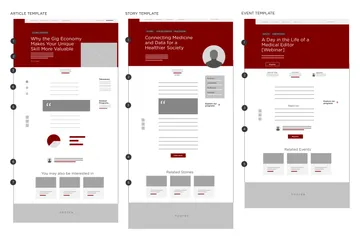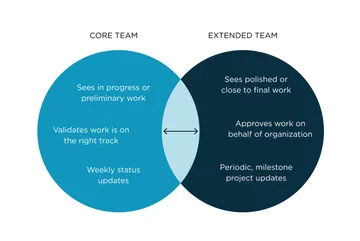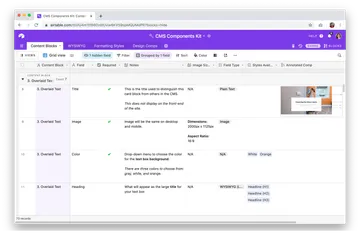Project Handoffs: Setting Your Clients Up For Success

Creating positive project handoff experiences are important for the long-term success of a new brand or marketing initiative.
A project handoff is a make-or-break moment for clients. It sets the tone for future implementation and can define what type of relationship you and your client will have in the future. Have a negative project handoff and you may leave clients feeling uneasy or lost. Have a positive project handoff and they’ll be excited to take the reins and feel grateful for having you as a partner.
In this article, we’ll define some simple principles for creating a positive project handoff experience for both you and your client. We’ll go into:
- Making recommendations manageable and aligned with your client team’s capabilities
- Finding the right stakeholders to foster shared ownership with
- Embracing over-delivery of documentation to keep expectations clearly communicated
Make it manageable
When preparing for a project handoff, remember: what may come naturally to you may not come easy for your client. That’s why they needed your help in the first place. No matter how brilliant your recommendations may be, the realities of your client’s business and their current capabilities still need to be factored in. That’s not to say you can’t push boundaries or be ambitious in your vision—you should always strive to do that. But to do that well means ensuring that what you are recommending is achievable; maybe not by tomorrow, or in six months, but it must be achievable.
If you can, work directly with the teams who will be responsible for implementing strategy and design directions. Find out how they’re organizing themselves and where the gaps are. Do they have writers on staff? Are they familiar with the CMS platform we’re using? Will other members of their organization need to be onboarded? Having open conversations about your client team’s capabilities and pain points will help you understand how they’re organizing themselves and where the gaps might be. How you bridge these is what will set your working relationship apart from others. In doing so, focus on tools and documentation that are tailored and actionable. Maybe that’s a one-off Google Site with annotated design documents, or pre-CMS content template and migration checklists to guide content creation. In addressing these obstacles, clients can confidently move forward and govern their vision autonomously.


Foster ownership early
Successful project handoffs usually happen when clients feel completely bought into the process, even as early on as the beginning stages of a project. They’ve been listened to and feel heard. They’ve been armed with all the information and empowered to make educated decisions. There is also a mutual respect for the value each of you brings to the table. If all those statements are true, then congrats, you’ve fostered shared ownership with your client.
This sounds simple but can oftentimes get complicated by how well aligned and involved all of the client’s organizational stakeholders are. Sometimes, these power dynamics and org charts are not immediately obvious to you as the person facilitating presentations and approvals. There is a simple framework you can use to help suss out who all the players are and how to keep them in sync: core team vs. extended team.

Core Team
Your core team will be the stakeholders who should be aware of work as it’s in progress. This core team will help vet ideas and act as a sounding board to validate that your work is on the right track. This usually consists of your direct point of contact along with 2-4 people empowered to represent their discipline or area of focus on behalf of their organization. Touchpoints for a core team may include creative workshops to brainstorm initial concepts, or regularly recurring work share sessions where they will see preliminary designs or code demos. This may also be the group that receives a weekly status report and gets in the weeds on timelines and milestones.
Extended Team
The extended team will be stakeholders who see work only in polished or near-final states. They’ll usually be the people that hold ultimate approval power and are responsible for the organization’s mission (and budgets). This group usually consists of upper-level management to c-suite members. Touchpoints for an extended team will usually only include in-person presentations at key milestones of the project.
The Overlap
There will naturally be some overlap between the core and extended team. These teams can also expand and contract at various moments of the project, allowing for members to either take a greater role than before, perhaps as things relate more to their area of interest, or recede from the grind as it makes sense.
By using this model, knowing when to elevate decisions, how to structure presentations, and who to include in meetings becomes a lot less ambiguous. And, ultimately, helps you foster ownership among all stakeholders in effective and appropriate ways.
More can be more
Particularly when it comes to handoffs, being aligned on who’s responsible for what is paramount. Don’t be shy about over-communicating expectations to confirm these roles and the time frame in which things need to get done. Not only will this ensure everyone understands what they need to do, but it also ensures that everyone understands what each party is not doing. It’s what’s in that “not” column that can be easily assumed as someone else’s responsibility, which can cause undue stress, especially towards the last few weeks of a project.
The final wrap up of a project is also a great opportunity to overdeliver on documentation. Organize and annotate design files so they are easy to navigate, catalog functional requirements for developers, and prototype out animations or user interactions. This will be time well spent, saving time later on when clients don’t have to come back to you to ask for information or guidance.


Last but not least, when delivering documentation, review it together with the client. Set up a call to walk through materials to make sure everyone understands its contents. This is a sure-fire way to know that these materials were looked at and absorbed instead of getting stuck in someone’s inbox. Even better, it will let you know right away if the information is unclear, thus giving everyone another opportunity to clarify questions before moving on.
These simple principles can help start a project handoff, or a transition in ownership, off on the right foot. Not only will this help you with a smooth transition of ownership as a project winds down, but these are also valuable lessons to remember for any stage of a project. Valuing your client’s perspective, making recommendations clear and specific, and keeping everyone involved included and properly utilized will always set you, and your client, up for success.
